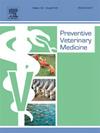A dynamic framework for calculating the biomass of fattening pigs with an application in estimating the burden of porcine reproductive and respiratory syndrome in the Netherlands
IF 2.2
2区 农林科学
Q1 VETERINARY SCIENCES
引用次数: 0
Abstract
Gaining insight into the size and composition of national pig populations can support decisions on disease control, welfare, and environmental sustainability. However, if one needs to draw meaningful comparisons between the performance of various production systems or countries, a method for standardization is required. One approach to achieve this is by means of biomass estimation. The objective of this study was to develop a biomass estimation framework that can provide detailed and reliable estimates of fattening pig biomass disaggregated by pig life stage (suckling, weaning and fattening), while accounting for the dynamic nature of pig populations. The framework was developed on publicly accessible data pertaining to pig production in the Netherlands, and we additionally assessed availability of required data for several other European countries (Spain, Germany, and Great Britain). Three distinct life stages—suckling piglets, weaning pigs, and fattening pigs—are considered in the framework. Demographic and movement data, including yearly imports, exports, and slaughter numbers, along with standing populations, were collected from official governmental sources. Required production parameters were sourced from representative surveys, with missing parameters supplemented by private industry reports or expert elicitation. The results from the framework for the Netherlands yield insights into the Dutch pig sector. In 2020, 156 million kg, 552 million kg, and 1654 million kg of biomass were produced in the suckling, weaning, and fattening stages, respectively. The evaluation against census data indicated the framework's reliability, with deviations mostly below 10 %. Data availability assessments for Spain, Germany and Great Britain reveal variations in data completeness and underscore the importance of local contacts and language expertise when extending the framework to other countries. The framework's relevance was further demonstrated through an illustrative application, assessing the impact of porcine reproductive and respiratory syndrome on pig biomass in the Netherlands. In the most severe disease scenario, the produced biomass decreased by 13 %, 17 %, and 66 % in the suckling, weaning, and fattening stages, respectively. Beyond disease burden estimation, the biomass estimates can be used as a denominator for various purposes to provide efficiency metrics, such as the amount of antibiotics used or the volume of greenhouse gases emitted per kilogram of pig biomass produced. While the framework could benefit from further refinement regarding resource use and economic values, its current iteration provides a robust and unique foundation for estimating biomass disaggregated by pig life stage, aiding decision-makers in the agricultural and veterinary sector.
计算育肥猪生物量的动态框架,应用于估算荷兰猪繁殖与呼吸综合征的负担。
深入了解各国猪群的规模和组成,有助于在疾病控制、福利和环境可持续性方面做出决策。然而,如果需要对不同生产系统或国家的表现进行有意义的比较,就需要一种标准化的方法。实现这一目标的方法之一就是生物量估算。本研究的目的是开发一个生物量估算框架,该框架可提供按猪的生命阶段(乳猪、断奶猪和育肥猪)分列的详细可靠的育肥猪生物量估算,同时考虑到猪群的动态特性。该框架是根据荷兰公开的生猪生产数据开发的,我们还评估了其他几个欧洲国家(西班牙、德国和英国)所需数据的可用性。该框架考虑了三个不同的生命阶段--哺乳仔猪、断奶猪和育肥猪。人口和移动数据,包括年度进口、出口和屠宰数量,以及常住人口,均从政府官方来源收集。所需的生产参数来自有代表性的调查,缺失的参数由私营企业报告或专家意见补充。荷兰框架得出的结果有助于深入了解荷兰养猪业。2020 年,乳猪、断奶猪和育肥猪阶段的生物量分别为 1.56 亿公斤、5.52 亿公斤和 1.65 亿公斤。根据普查数据进行的评估表明,该框架非常可靠,偏差大多低于 10%。对西班牙、德国和英国进行的数据可用性评估表明,数据的完整性存在差异,并强调了在将该框架推广到其他国家时当地联系和语言专业知识的重要性。通过评估猪繁殖与呼吸综合征对荷兰猪只生物量的影响这一示例应用,进一步证明了该框架的相关性。在疾病最严重的情况下,乳猪、断奶猪和育肥猪的生产生物量分别减少了 13%、17% 和 66%。除疾病负担估算外,生物量估算值还可用作各种用途的分母,以提供效率指标,如抗生素使用量或每公斤生猪生物量的温室气体排放量。虽然该框架在资源利用和经济价值方面还需进一步完善,但其目前的迭代为估算按猪生命阶段分列的生物量提供了一个强大而独特的基础,有助于农业和兽医领域的决策者。
本文章由计算机程序翻译,如有差异,请以英文原文为准。
求助全文
约1分钟内获得全文
求助全文
来源期刊

Preventive veterinary medicine
农林科学-兽医学
CiteScore
5.60
自引率
7.70%
发文量
184
审稿时长
3 months
期刊介绍:
Preventive Veterinary Medicine is one of the leading international resources for scientific reports on animal health programs and preventive veterinary medicine. The journal follows the guidelines for standardizing and strengthening the reporting of biomedical research which are available from the CONSORT, MOOSE, PRISMA, REFLECT, STARD, and STROBE statements. The journal focuses on:
Epidemiology of health events relevant to domestic and wild animals;
Economic impacts of epidemic and endemic animal and zoonotic diseases;
Latest methods and approaches in veterinary epidemiology;
Disease and infection control or eradication measures;
The "One Health" concept and the relationships between veterinary medicine, human health, animal-production systems, and the environment;
Development of new techniques in surveillance systems and diagnosis;
Evaluation and control of diseases in animal populations.
 求助内容:
求助内容: 应助结果提醒方式:
应助结果提醒方式:


